Proper betta fish care ensures your fish lives a long, healthy, and vibrant life. Bettas can thrive for 3-5 years with the right environment, nutrition, and maintenance. This complete betta fish care guide covers everything from tank setup to daily routines, giving you the knowledge to provide excellent care for your betta.
| Care Aspect | Requirement | Importance |
| Tank Size | 5+ gallons minimum | Critical |
| Water Temperature | 78-80°F | Critical |
| Feeding | 2-4 pellets, twice daily | High |
| Water Changes | 25% weekly | Critical |
| Filter | Yes, gentle flow | High |
| Heater | Yes, adjustable | Critical |
| Plants/Hiding | Multiple spots | Medium |
| Tank Mates | Optional, careful selection | Low |
Understanding how to care for betta fish properly prevents most health problems. The majority of betta illnesses come from poor water quality, wrong temperature, or improper feeding. Get these basics right and your betta will flourish.
⚠️ Important Health Notice: This guide provides general betta fish care information based on established aquarium practices and personal experience. While this information helps maintain healthy bettas, it does not replace professional veterinary advice. If your betta shows signs of serious illness, stops eating for more than 3 days, or displays unusual behavior, consult an aquatic veterinarian. Early professional intervention saves lives.
Caring for betta fish requires understanding their natural habitat and needs. Wild bettas live in warm, shallow waters of Southeast Asia. Rice paddies, slow streams, and marshes provide their home. These waters stay warm year-round and contain plenty of hiding spots.
Your betta fish care routine should recreate these natural conditions. Warm water between 78-80°F is essential. Bettas are tropical fish and cannot survive in cold water. Room temperature water (68-72°F) slowly kills bettas even though they seem fine initially.
Clean water matters more than almost anything else. Bettas breathe from the water and absorb everything dissolved in it. Dirty water causes stress, disease, and early death. Regular water changes and proper filtration keep water safe.
Adequate space lets bettas swim and explore naturally. The old myth about bettas living in cups or bowls has killed millions of fish. Bettas need room to move, just like any other pet. Minimum 5 gallons provides basic space for one betta. Proper nutrition maintains health and color. High-quality betta food provides necessary protein and vitamins. Overfeeding causes more problems than underfeeding. Learning correct portions prevents digestive issues and water pollution.
In my 10 years of keeping bettas, I’ve learned that consistency matters most. Daily feeding at the same time. Weekly water changes on schedule. Monthly deep cleaning. Regular routines keep bettas healthy and reduce stress.
Recognizing health problems early saves betta lives. Check your fish daily during feeding time. Healthy bettas look and act very different from sick ones.
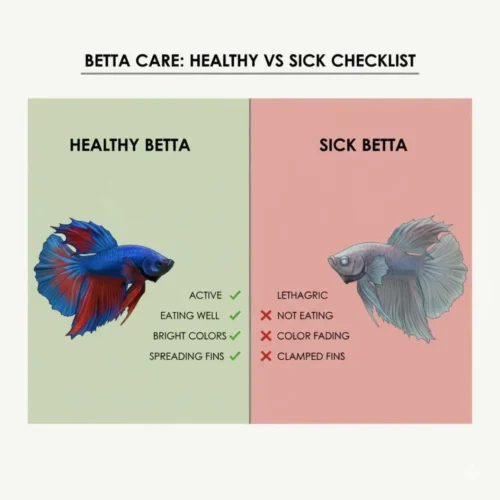
A healthy betta fish swims actively around the tank. Colors look vibrant and fins spread fully. The fish comes to the front when you approach. Eating happens enthusiastically. These signs tell you everything is working well.
| Feature | Healthy Signs |
| Fins | Fully spread, no tears or holes |
| Colors | Bright, vibrant, rich |
| Scales | Smooth, flat against body |
| Eyes | Clear, not cloudy or bulging |
| Body | Streamlined, no swelling |
| Gills | Pink/red, smooth movement |
| Skin | No white spots, fuzz, or slime |
| Behavior | Healthy Pattern |
| Swimming | Active, explores entire tank |
| Appetite | Eager to eat at feeding time |
| Breathing | Steady, calm gill movement |
| Response | Reacts to your presence |
| Energy | Alert, investigates new things |
| Rest | Normal periods at night |
| Flaring | Occasional display behavior |
| Symptom | Indicates Problem |
| Clamped fins | Stress or illness |
| Faded colors | Stress, poor water, or disease |
| White spots | Ich parasite infection |
| Cotton-like growth | Fungal infection |
| Swollen belly | Overfeeding, dropsy, or constipation |
| Torn/ragged fins | Fin rot disease |
| Bulging eyes | Popeye infection |
| Gasping at surface | Poor water quality or gill problem |
| Lethargy | Various health issues |
| Loss of appetite | Most diseases start here |
| Floating/sinking | Swim bladder disorder |
Sick betta fish signs appear gradually. The first symptom is usually behavior change. A normally active betta becomes lethargic. An eager eater refuses food. These early warnings allow quick treatment.
Physical symptoms follow behavioral changes. Clamped fins, faded colors, or visible spots indicate advancing problems. Never ignore these signs. Early treatment prevents minor issues from becoming fatal.
| Equipment | Purpose | Specifications |
| Tank | Living space | 5+ gallons minimum |
| Heater | Temperature control | 25-50 watt adjustable |
| Thermometer | Monitor temperature | Digital or glass |
| Filter | Water cleaning | Gentle flow, sponge or HOB |
| Light | Day/night cycle | LED, 8-10 hours daily |
| Water Conditioner | Remove chlorine | Follow bottle directions |
| Test Kit | Check parameters | Liquid test preferred |
| Net | Move fish safely | Soft mesh, small |
| Gravel Vacuum | Clean substrate | Standard siphon |
| Food | Nutrition | High-quality pellets |
Optional But Helpful:
| Item | Benefit |
| Live plants | Natural filtration, hiding spots |
| Indian almond leaves | Natural water conditioning |
| Air stone | Extra oxygenation |
| Hospital tank | Treat sick fish |
| Timer | Automated lighting |
Quality equipment prevents most betta problems. Cheap heaters fail and kill fish. Unreliable thermometers give wrong readings. Harsh filters stress bettas. Investing in proper equipment from the start saves money and fish lives.
Tank Size Guide:
| Tank Size | Suitable For | Notes |
| Under 2.5 gallons | NOT SUITABLE | Too small, parameters unstable |
| 2.5-5 gallons | Emergency only | Difficult to maintain, frequent changes needed |
| 5-10 gallons | Minimum acceptable | Good for single betta, manageable |
| 10-20 gallons | Recommended | Stable parameters, room for tank mates |
| 20+ gallons | Ideal | Best stability, multiple hiding spots |
The best tank for betta fish is 10 gallons or larger. Bigger tanks maintain stable water conditions. Temperature stays consistent. Waste dilutes better. Your betta has room to swim and explore naturally.
Five gallons is the absolute minimum for betta fish tank setup. Anything smaller cannot support healthy betta living conditions. Small containers create toxic conditions quickly. Bettas in bowls or cups suffer constantly even if they survive.
Tank shape matters too. Longer horizontal tanks work better than tall narrow ones. Bettas swim side to side more than up and down. A 10-gallon long tank beats a 10-gallon tall tank for betta habitat quality.
Bettas need regular day and night cycles. Light helps regulate their internal clock and supports plant growth. Too much light stresses bettas and grows algae. Too little disrupts their schedule.
Lighting Schedule:
| Time Period | Light Status | Duration |
| Daytime | On | 8-10 hours |
| Evening | Off | 14-16 hours |
| Consistency | Same daily schedule | Critical |
Use a timer for consistent lighting. Turn lights on at 8 AM and off at 6 PM works well. Bettas need darkness to sleep properly. Constant light causes stress and health problems.
Natural sunlight works but requires careful placement. Direct sun causes temperature spikes and algae blooms. Indirect natural light provides gentle illumination. Most keepers use LED aquarium lights for better control.
Bettas can live alone or with compatible tank mates. Male bettas cannot live with other male bettas ever. They fight to the death. Female bettas sometimes live together in sorority groups.
Safe Tank Mate Options:
| Species | Compatibility | Tank Size Needed |
| Mystery snails | Excellent | 5+ gallons |
| Nerite snails | Excellent | 5+ gallons |
| Ghost shrimp | Good | 10+ gallons |
| Cory catfish | Very good | 20+ gallons |
| Neon tetras | Moderate | 20+ gallons |
| Harlequin rasboras | Very good | 20+ gallons |
| African dwarf frogs | Good | 10+ gallons |
Peaceful, non-flashy fish work best. Bottom-dwelling species avoid bettas naturally. Small schooling fish keep to themselves. Never add aggressive or fin-nipping species.
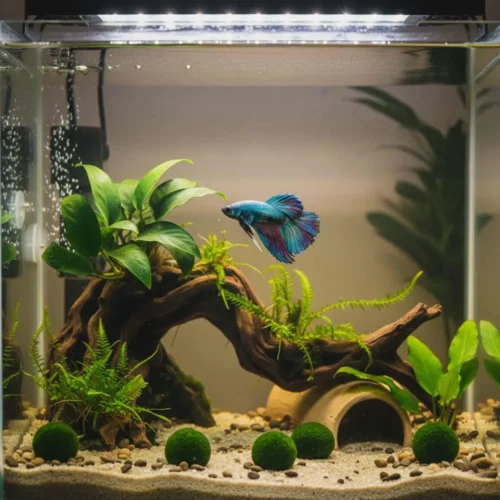
Live plants improve betta fish environment significantly. Plants produce oxygen, absorb waste, and provide hiding spots. Bettas feel more secure in planted tanks.
Easy Live Plants for Bettas:
| Plant | Difficulty | Placement | Benefits |
| Java Fern | Very easy | Tied to decor | Low light, hardy |
| Anubias | Very easy | Tied to decor | Tough leaves, low light |
| Amazon Sword | Easy | Planted in substrate | Large hiding spots |
| Java Moss | Very easy | Tied anywhere | Natural look |
| Marimo moss ball | Very easy | Bottom or floating | Fun interaction |
| Water Sprite | Easy | Floating or planted | Fast growing |
| Hornwort | Very easy | Floating | Excellent filtration |
Silk or soft plastic plants work if live plants seem difficult. Avoid plastic plants with sharp edges. These tear delicate betta fins. Run pantyhose over decorations – if it snags, it will tear fins.
Bettas love exploring caves, tunnels, and hiding spots. Decorations reduce stress by providing security. Multiple hiding places work better than one large decoration.
Decoration Safety Checklist:
✅ Smooth edges (no sharp points)
✅ No small holes (betta can’t get stuck)
✅ Stable (won’t tip and trap fish)
✅ Non-toxic (aquarium-safe materials)
✅ Easy to clean
✅ Appropriate size for tank
Driftwood, smooth rocks, and ceramic caves work excellently. Avoid metal decorations that rust. Skip painted items that chip. Natural materials are safest.
I arrange decorations to create swimming lanes. Bettas enjoy weaving through plants and around objects. Open swimming space matters as much as hiding spots.
Temperature Requirements:
| Aspect | Specification |
| Ideal range | 78-80°F |
| Acceptable range | 76-82°F |
| Dangerous below | 74°F |
| Dangerous above | 84°F |
| Stability | ±2°F maximum fluctuation |
A reliable betta fish heater is absolutely essential. Room temperature kills bettas slowly. Cold water suppresses their immune system. Metabolism slows. Digestion stops. Disease attacks weakened fish.
Heater Selection Guide:
| Tank Size | Heater Wattage | Type |
| 5 gallons | 25 watts | Adjustable |
| 10 gallons | 50 watts | Adjustable |
| 20 gallons | 75-100 watts | Adjustable |
| 30+ gallons | 100-150 watts | Adjustable |
Always use an adjustable heater. Preset heaters often run too hot or cold. Adjustable models let you set exact temperature. Check temperature daily with a separate thermometer. Heaters fail, and thermometers verify safety.
Place your betta fish thermometer away from the heater. This shows actual tank temperature, not just heated water near the heater. Digital thermometers work better than stick-on types.
Betta tank filter choice affects fish comfort significantly. Bettas come from still or slow-moving water. Strong filter currents exhaust them. The right filter cleans water without creating rapids.
Best Filter Types for Bettas:
| Filter Type | Pros | Cons | Best For |
| Sponge filter | Gentle flow, beneficial bacteria | Needs air pump | 5-10 gallons |
| HOB (low flow) | Good filtration, adjustable | Can be too strong | 10+ gallons with baffle |
| Internal filter | Space-saving, adjustable | Takes tank space | 5-20 gallons |
| Canister | Excellent filtration | Expensive, overkill | 30+ gallons |
Baffle strong filters using sponge or craft mesh. This spreads water flow and reduces current. Bettas should swim easily without fighting water movement.
Clean filter media monthly in old tank water. Never use tap water – it kills beneficial bacteria. Squeeze sponges gently to remove debris. Replace chemical media according to package directions.
Water Parameters for Bettas:
| Parameter | Ideal Range | Acceptable Range | Testing Frequency |
| Ammonia | 0 ppm | 0 ppm (never higher) | Weekly |
| Nitrite | 0 ppm | 0 ppm (never higher) | Weekly |
| Nitrate | 0-10 ppm | 0-20 ppm | Weekly |
| pH | 6.5-7.5 | 6.0-8.0 | Weekly |
| Hardness | 5-15 dGH | 3-20 dGH | Monthly |
Use quality water conditioner every water change. Tap water contains chlorine and chloramine that kill fish instantly. Conditioner neutralizes these chemicals in seconds.
Age tap water 24 hours before use if possible. This allows chlorine to evaporate naturally. Bring aged water to tank temperature before adding. Temperature shock harms bettas.
Test water weekly at minimum. Testing catches problems before they kill fish. Liquid test kits provide accurate readings. Strip tests work but are less precise.
Test Results and Actions:
| Reading | Meaning | Action Required |
| Ammonia >0 | Toxic buildup | 50% water change immediately |
| Nitrite >0 | Cycle incomplete or crashed | Daily water changes until 0 |
| Nitrate >20 | Needs cleaning | 25-50% water change |
| pH <6.0 or >8.0 | Outside safe range | Gradual adjustment needed |
The nitrogen cycle processes fish waste safely. Beneficial bacteria convert toxic ammonia to nitrite, then nitrite to less toxic nitrate. This cycle takes 4-6 weeks to establish in new tanks.
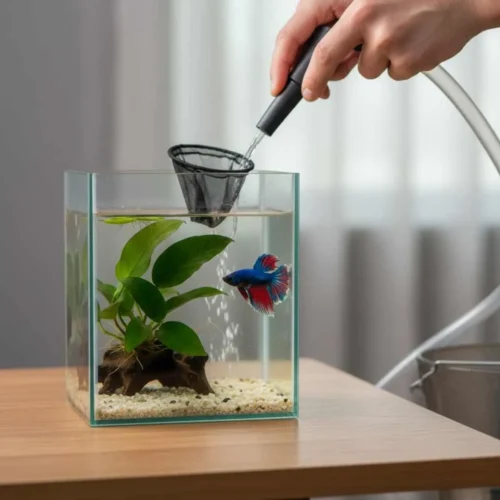
Cleaning Schedule by Tank Size:
| Tank Size | Water Change Frequency | Amount | Deep Clean |
| 2.5-5 gallons | Every 3-4 days | 25-30% | Weekly |
| 5-10 gallons | Weekly | 25% | Monthly |
| 10-20 gallons | Weekly | 20-25% | Monthly |
| 20+ gallons | Weekly | 20% | Every 6 weeks |
Never change 100% of water at once. This removes beneficial bacteria and shocks your betta. Partial water changes maintain stability while removing waste.
How to clean betta tank depends on filtration and stocking. Filtered tanks need less frequent changes than unfiltered bowls. Heavily planted tanks sometimes need less cleaning because plants absorb waste.
Step-by-Step Tank Cleaning:
Weekly Partial Water Change:
Monthly Deep Clean:
Never use soap, bleach, or household cleaners. These chemicals kill fish even in tiny amounts. Hot water and elbow grease clean everything safely.
I use a dedicated bucket only for aquarium use. This prevents contamination from cleaning products. Label the bucket clearly to avoid accidents.
Weekly Routine:
Consistency matters more than specific days. Choose a schedule you can maintain forever. Missing water changes causes parameter swings that stress bettas.
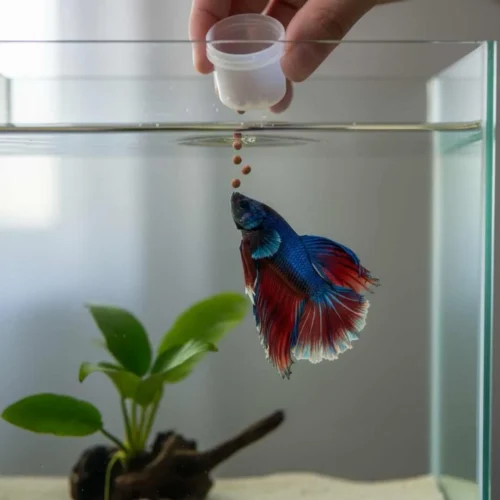
Food Type Comparison:
| Food Type | Pros | Cons | Frequency |
| High-quality pellets | Balanced nutrition, convenient | Can cause bloating if not soaked | Daily staple |
| Frozen bloodworms | High protein, bettas love them | Need freezer space | 2-3 times weekly |
| Frozen brine shrimp | Good protein, easy to digest | Less nutritious than bloodworms | 2-3 times weekly |
| Freeze-dried foods | Long shelf life, good treats | Can cause bloating, soak first | Occasional treats |
| Live foods | Highest nutrition, enrichment | Hard to find, disease risk | When available |
What to feed betta fish depends on age and health. Adult bettas thrive on quality pellets as the staple. Frozen foods provide variety and enrichment. Mix different foods for balanced betta fish diet.
Avoid flake food as the primary diet. Flakes contain fillers and lose nutrition quickly. Pellets maintain nutrition better and create less waste.
Daily Feeding Guide:
| Time | Food | Amount |
| Morning (8-9 AM) | Pellets | 2-4 pellets |
| Evening (6-7 PM) | Pellets or frozen | 2-4 pellets or equivalent |
| Fasting day | None | Skip one day weekly |
How often feed betta matters for health. Twice daily feedings prevent overfeeding while maintaining energy. Feed only what your betta eats in 2-3 minutes.
Young bettas under 6 months need 3-4 small feedings daily. Their growing bodies require more nutrition. Reduce to twice daily once fully grown.
Fast your betta one day weekly. This prevents constipation and gives the digestive system rest. I fast all my bettas on Sunday. This simple habit prevents many health issues.
Overfeeding betta kills more fish than almost any other mistake. Bettas have stomachs the size of their eyeball. Tiny amounts satisfy their needs. Extra food causes multiple problems.
| Problem | How It Happens |
| Swim bladder disorder | Swollen stomach presses on swim bladder |
| Constipation | Too much food clogs digestive system |
| Obesity | Excess calories stored as fat |
| Poor water quality | Uneaten food rots and pollutes water |
| Ammonia spikes | Excess waste overwhelms beneficial bacteria |
| Shortened lifespan | Organ stress from constant overfeeding |
Pellets expand in water. Dry pellets swell inside your betta’s stomach. This causes severe bloating. Always soak pellets 2-3 minutes before feeding.
Watch your betta’s belly. A slightly rounded belly after eating is normal. A severely distended belly indicates overfeeding. Reduce portions immediately.
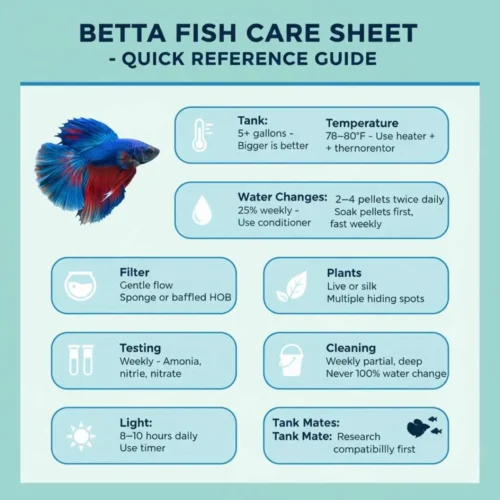
Quick Reference Care Sheet:
| Category | Requirement | Details |
| TANK | 5+ gallons | Bigger is better |
| TEMPERATURE | 78-80°F | Use heater + thermometer |
| WATER CHANGES | 25% weekly | Use conditioner |
| FEEDING | 2-4 pellets, twice daily | Soak pellets first, fast weekly |
| FILTER | Gentle flow | Sponge or baffled HOB |
| PLANTS | Live or silk | Multiple hiding spots |
| TESTING | Weekly | Ammonia, nitrite, nitrate |
| CLEANING | Weekly partial, monthly deep | Never 100% water change |
| LIGHT | 8-10 hours daily | Use timer |
| TANK MATES | Optional | Research compatibility first |
✅ Feed morning and evening
✅ Check temperature
✅ Observe fish behavior
✅ Remove uneaten food
✅ Test water parameters
✅ 25% water change
✅ Vacuum substrate
✅ Check equipment
✅ Deep clean tank
✅ Clean filter
✅ Trim plants
✅ Replace worn equipment
Complete Maintenance Schedule:
| Task | Purpose | Notes |
| Feed 2x daily | Nutrition | 2-4 pellets per feeding |
| Check temperature | Safety | Should be 78-80°F |
| Observe behavior | Health monitoring | Note any changes |
| Check equipment | Prevent failures | Heater, filter running? |
| Task | Purpose | Notes |
| Test water | Catch problems early | Ammonia, nitrite, nitrate |
| 25% water change | Remove waste | Match temperature |
| Vacuum substrate | Clean debris | During water change |
| Wipe algae | Visibility, aesthetics | Use aquarium sponge |
| Check plants | Remove dead leaves | Trim if needed |
| Task | Purpose | Notes |
| Deep clean | Remove buildup | 50% water change |
| Clean filter | Maintain efficiency | In old tank water |
| Clean decorations | Remove algae | No soap, just water |
| Inspect equipment | Prevent failures | Replace if worn |
| Treat with tannins | Water conditioning | Indian almond leaves optional |
| Task | Purpose | Notes |
| Replace filter media | Maintain filtration | Chemical media mainly |
| Check heater accuracy | Safety | Compare to thermometer |
| Deep substrate clean | Remove deep waste | More thorough vacuuming |
| Replace worn decor | Safety | Sharp edges develop over time |
Proper betta care schedule prevents most problems. Consistency matters more than perfection. Missing one water change occasionally won’t kill your fish. But chronic neglect always does.
| Betta Type | Special Considerations |
| Halfmoon | Large fins need gentle current, prone to fin damage |
| Crowntail | Spiky fins tear easily, avoid sharp decorations |
| Plakat | Short fins, more active, needs swimming room |
| Double tail | Swim bladder issues more common, avoid overfeeding |
| Dumbo/Elephant ear | Large pectoral fins, needs extra space |
| Koi/Marble | Color changes normal, same care as others |
| Wild type | More active, prefer complex environments |
| Giant betta | Needs 10+ gallons minimum, eats more |
| Life Stage | Age | Special Needs |
| Fry | 0-2 months | Multiple daily feedings, pristine water |
| Juvenile | 2-6 months | 3-4 feedings daily, growing body needs more |
| Adult | 6 months – 3 years | Standard care, twice daily feeding |
| Senior | 3+ years | Gentler current, more rest areas, possible diet adjustment |
Baby bettas (under 4 months) cannot fast safely. They need food 3-4 times daily for proper growth. Adult betta fish care includes weekly fasting that juveniles cannot handle.
Annual Betta Care Calendar:
January – March:
April – June:
July – September:
October – December:
Year-Round Monthly:
In my 10 years of betta keeping, I’ve found that scheduled maintenance prevents 95% of problems. The bettas I’ve lost were usually from skipping routines or taking shortcuts.
Critical Mistakes and Solutions:
| Mistake | Why It’s Harmful | Correct Approach |
| Bowl or tiny tank | Unstable parameters, no space | 5+ gallon filtered tank |
| No heater | Cold water weakens immunity | 78-80°F with heater always |
| Overfeeding | Obesity, swim bladder, dirty water | 2-4 pellets twice daily, fast weekly |
| 100% water changes | Removes beneficial bacteria, pH shock | 25% weekly, never 100% |
| Tap water without conditioner | Chlorine kills fish | Always use water conditioner |
| No cycling | Ammonia and nitrite poison fish | Cycle tank 4-6 weeks before adding fish |
| Aggressive tank mates | Stress, injury, death | Research compatibility thoroughly |
| Sharp decorations | Torn fins, injury | Only smooth, soft materials |
| Irregular maintenance | Parameter swings, stress | Consistent schedule |
| Ignoring symptoms | Minor problems become fatal | Address issues immediately |
Water Quality Mistakes:
Never use distilled or reverse osmosis water alone. These lack minerals bettas need. Mix with tap water or add minerals.
Don’t trust “beneficial bacteria in a bottle” to instant-cycle tanks. Some products help, but nothing replaces time. Cycle tanks properly before adding fish.
Never use aquarium salt regularly. Salt treats specific conditions but harms bettas long-term in freshwater. Only use when treating disease.
First-Time Owner Essentials:
Starting with betta fish care for beginners feels overwhelming. Focus on these priorities first:
Week 1 Priorities:
Week 2-4 Priorities:
Month 2-3 Priorities:
Beginner Shopping List:
| Priority | Item | Estimated Cost |
| Essential | 5-10 gallon tank kit | $30-60 |
| Essential | Adjustable heater | $15-25 |
| Essential | Thermometer | $3-8 |
| Essential | Water conditioner | $5-10 |
| Essential | Betta pellets | $5-10 |
| Essential | Test kit (liquid) | $20-30 |
| Recommended | Live plants | $10-20 |
| Recommended | Hiding spots | $10-20 |
| Recommended | Gravel vacuum | $10-15 |
| Optional | Timer for light | $8-15 |
| Total | Basic setup | $116-223 |
Simple betta care starts with the right equipment. Don’t skip essentials to save money. Cheap heaters fail. Missing test kits mean you’re guessing about safety. Do it right from day one.
Easy betta care comes from good habits. Feed at the same times daily. Test water every Wednesday. Change water every Sunday. Routines become automatic quickly.
Important Care Reminder: Every betta has unique personality and needs. What works perfectly for one fish may need adjustment for another. Observe your specific betta closely. Adjust care based on their individual behavior and responses. The guidelines in this article provide proven foundations, but your betta will teach you their specific preferences over time. Trust your observations and don’t hesitate to seek help when uncertain.
Proper betta fish care combines the right environment, consistent maintenance, and attentive observation. Your betta depends entirely on you for every aspect of their wellbeing. The time and effort you invest directly determines their health, happiness, and lifespan.
Start with the fundamentals: minimum 5-gallon tank, heater maintaining 78-80°F, gentle filtration, and weekly 25% water changes. These basics prevent most health problems before they start. Add live plants, appropriate decorations, and quality nutrition to support complete wellness.
Establish routines and stick to them. Feed at the same times daily. Test water weekly. Perform maintenance on schedule. Consistency reduces stress and keeps parameters stable. Your betta thrives on predictable care.
Watch your fish closely every day. Behavior changes signal problems before physical symptoms appear. Early detection allows quick treatment. Most illnesses are treatable when caught early. Ignoring signs leads to preventable deaths.
Remember that caring for betta fish is a long-term commitment. These beautiful fish live 3-5 years with proper care. Some reach 7+ years in exceptional conditions. Every day of excellent care adds to their lifespan and quality of life.
This complete betta fish care guide provides everything needed for success. From choosing equipment to daily routines, you now have the knowledge to provide excellent care. Your betta will reward proper care with vibrant colors, active behavior, and years of companionship.
Welcome to the rewarding world of betta fish keeping. Your journey with these magnificent fish starts with the commitment to proper care.